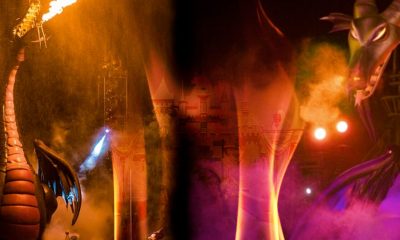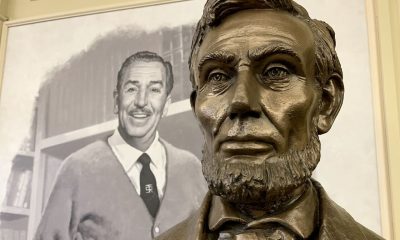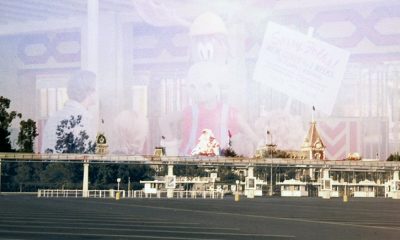Theme Parks & Themed Entertainment
“House of the Future” – The Plastic House in Disneyland
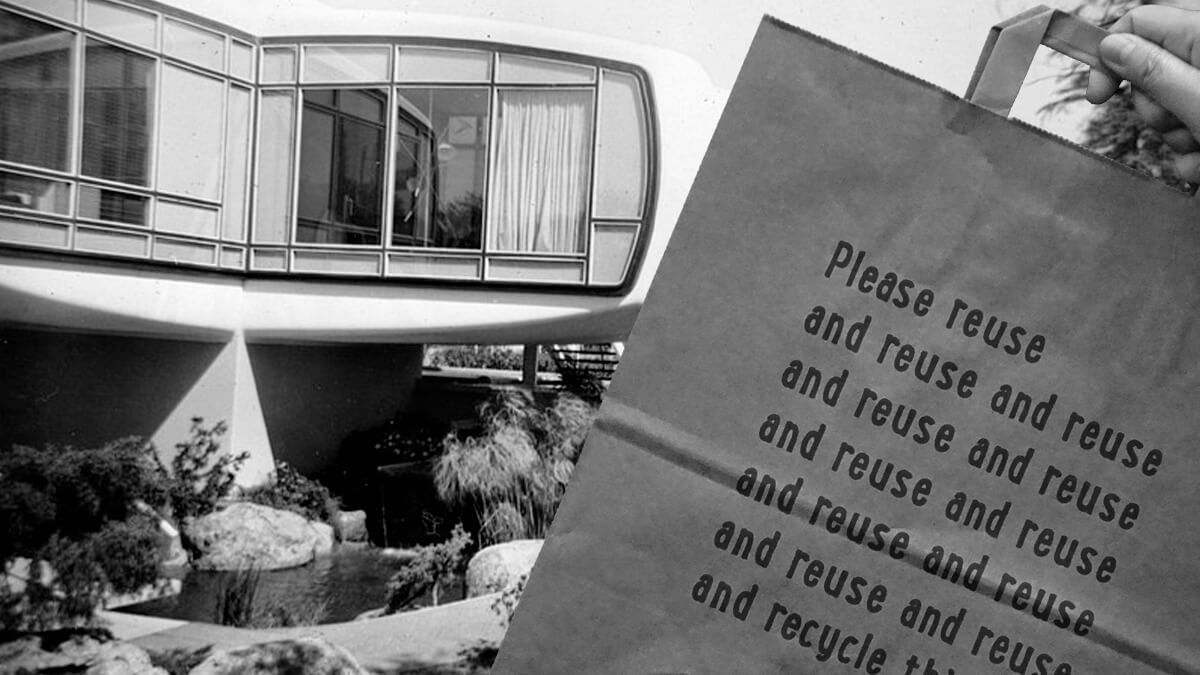
I was down in Massachusetts the other day doing some shopping at the Target in Framingham. And as I completed that transaction, I was somewhat surprised to see my groceries being loaded into … Well, not the usual Target bags (i.e., those white plastic ones with the bright red circular Target symbol on the side). But – rather – some plain jane brown paper bags.
Of course, that was because the State of Massachusetts (along with California, Connecticut, Delaware, Hawaii, Maine, New York, Oregon, Vermont & Washington State) has banned the use of plastic bags within the borders of that state.
FYI: The State of New Jersey put its own statewide ban of plastic bags in place earlier this year. On May 4, 2022, to be exact.
Which – if you’re a child of the 1960s – this is kind of an ironic development. Given that – back when we were kids – the world-at-large seemed to be actively looking for even more ways to incorporate the use of plastic in our day-to-day lives.
Which reminds me of one of the odder walk-thru experiences that was ever built at Disneyland Park (Which – given that Happiest Place on Earth was once home to the Hollywood-Maxwell’s Intimate Apparel Shop [This Main Street, U.S.A. store used to feature – no lie — a “Wonderful Wizard of Bras” show] – is really saying something). That was the “House of the Future,” a 1,280-square-foot structure that the Monsanto Corporation proudly proclaimed was made out of 14 different types of plastics.
Given that this Tomorrowland attraction wasn’t designed by the Imagineers … Well, how the “House of the Future” wind up being built right off Disneyland’s Hub to the left of the entrance of Disneyland?
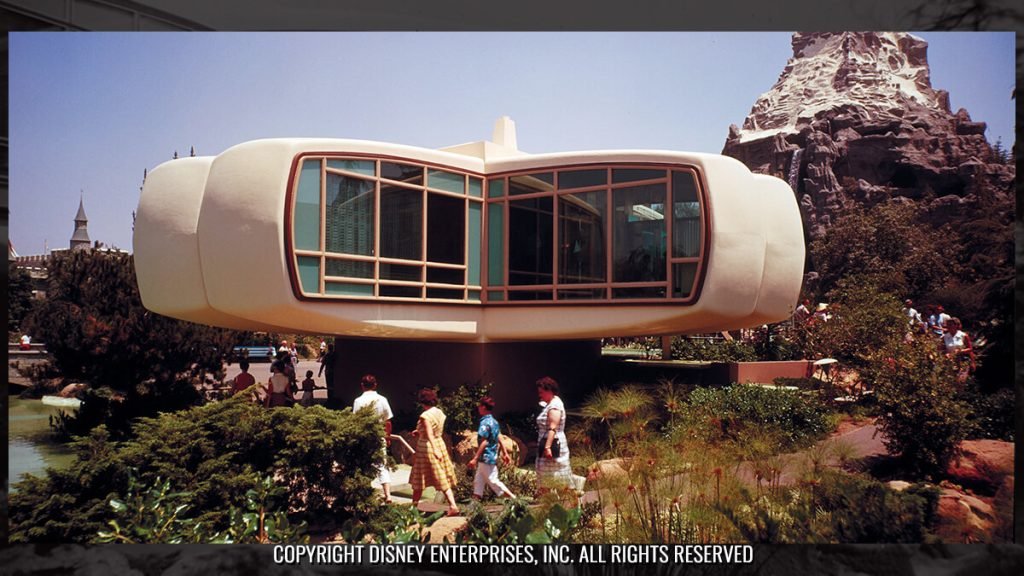
Post World War II – Moving Out of the City
Well, to tell that story, we have to jump back in time to the years right after World War II. Where – thanks to the G.I. Bill – hundreds of thousands of veterans decided to pursue college degrees. Which then allowed these former fighting men to land positions that paid much, much better than the jobs that their parents had held years previous.
And since these newly affluent veterans could now afford to move out of the city … Well, that’s just what they did. Which we saw places like Levittown (i.e., America’s very first planned community. The prototypical suburb, if you will) get founded in New York State’s Nassau in 1947 and – in just six years time – become the home of more than 70,000 residents.
Mind you, the downside of this sort of building boom is that – by the mid-1950s – America began to experience sort of a shortage when it came to the supplies necessary to continue to build all these new homes for would-be surburbanites.
Monsanto and Plastic Homes
Which the Monsanto Corporation – which was actively looking for additional way to market the plastic that that company produced – saw as an opportunity. Which is when Monsanto executives reached out to Marvin Goody & Richard Hamilton, who were members of the faculty at the Massachusetts Institute of Technology that taught the principles of architecture to students attending that prestigious university. And those execs then asked Goody & Hamilton two intriguing questions:
- Would it be possible to build an affordable modular home entirely out of plastic?
- And – if so – what would that structure look like?
These two MIT professors then went off and considered this problem. And the concept that Goody & Hamilton eventually came up with was … Well, this prefabricated plastic structure that consisted of four cantilevered “wings” that would then rise up off of a concrete slab, which would then as the foundation for what Monsanto was now calling its “House of the Future.”
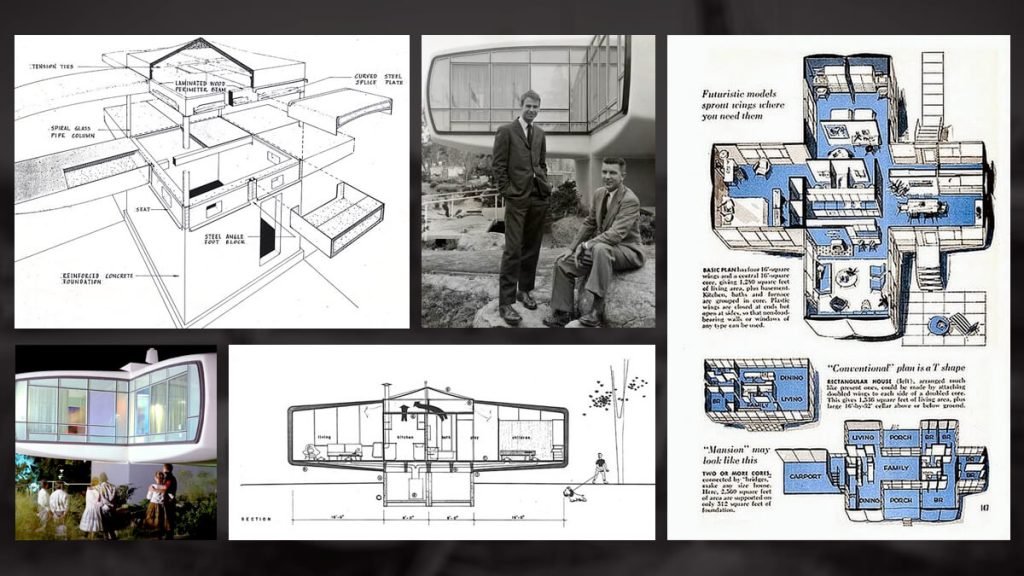
Credit: ModernDesign.org
And the executives at Monsanto just loved what Goody & Hamilton had designed & developed. They knew that – if this prefabricated plastic home prototype were promoted properly and if enough consumers then indicated to home-builders that they’d be interested in purchasing & then living in this sort of modular structure – the “House of the Future” could turn into a significant new revenue stream for that corporation.
Which is when Monsanto then began casting about for a very prominent spot where they could then build a “House of the Future” prototype. Some place where thousands of people could then tour this prefabricated plastic home every single day.
Walt Disney and Problems with Tomorrowland
Which brings us to Walt Disney. Who – in the mid-1950s – has a few problems of his own. Chief among them being that his then-newly-built Disneyland Park desperately needed some new attractions. Especially in the Tomorrowland section of Walt’s family fun park.
What’s genuinely ironic here is that – in spite of the fact that “Man in Space,” “Man and the Moon” and “Mars and Beyond” (i.e., A trio of “Tomorrowland” themed episodes of the “Disneyland” TV show which then aired on that ABC anthology series between March of 1955 & December of 1957) were among the most popular episodes to air on this program … The Tomorrowland section of Disneyland Park was this under-developed hodge-podge of pseudo-futuristic elements.
I mean, sure. This side of Walt’s family fun park had the “Flight to the Moon” ride. Likewise “Space Station X-1.” But right next door to these two genuinely forward-looking attractions were shows that had absolutely nothing to do with the future. Walk-through exhibits like the Dutch Boy Color Gallery, Kaiser’s Hall of Aluminum and Crane’s Bathroom of the Future.
Monsanto Corporation Partnership with Walt Disney Productions
Now it’s important to note here that the Monsanto Corporation and Walt Disney Productions already had a working relationship at this point. After all, Monsanto was already sponsoring an attraction at Disneyland, the Hall of Chemistry.
And it’s about this same time (we’re talking late 1956) that some enterprising executive at Monsanto thinks: “No wait a minute. Disneyland gets thousands of visitors every day. And if we build the prototype of our prefabricated plastic home there, our ‘House of the Future’ project would then virtually be guaranteed to get plenty of foot traffic.”
“House of the Future” in Disneyland
So they then reach out to Walt. And as the story goes, the executives at Monsanto hadn’t even finished their pitch for this prototype-prefabricated-plastic-home-to-be-displayed-at-Disneyland idea when Disney said “Yes.” In fact, according to what Disney Legend John Hench once told me, Walt was so enthusiastic about Monsanto’s “House of the Future” that he proposed that this prototype of a prefabricated plastic home not just be built in Tomorrowland but that it be built right at the entrance of Tomorrowland. As in: That the “House of the Future” would be one of the very first things Guests would see when they arrived at Disneyland’s Hub.
More importantly, that Monsanto’s prototype of a prefabricated plastic house be built right across the way from the most photographed thing in Walt’s family fun park. Which was – of course – Sleeping Beauty Castle.
To say that this project was fast-tracked is an understatement. Within weeks of signing the deal with Monsanto, the folks at Disneyland were already pouring the concrete slab that this 1,280-square-foot house would then sit on.
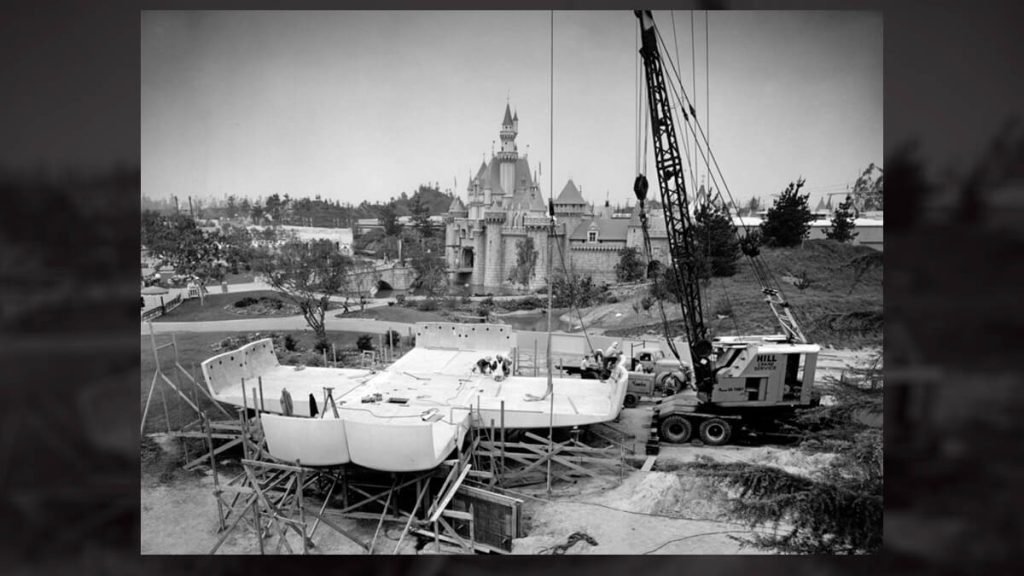
By the way, to make sure that virtually every Disneyland Guest would be able to tour the “House of the Future” when they visited Walt’s family fun park, this new Tomorrowland attraction was heavily hyped as being a freebie. As was Monsanto’s Hall of Chemistry, by the way.
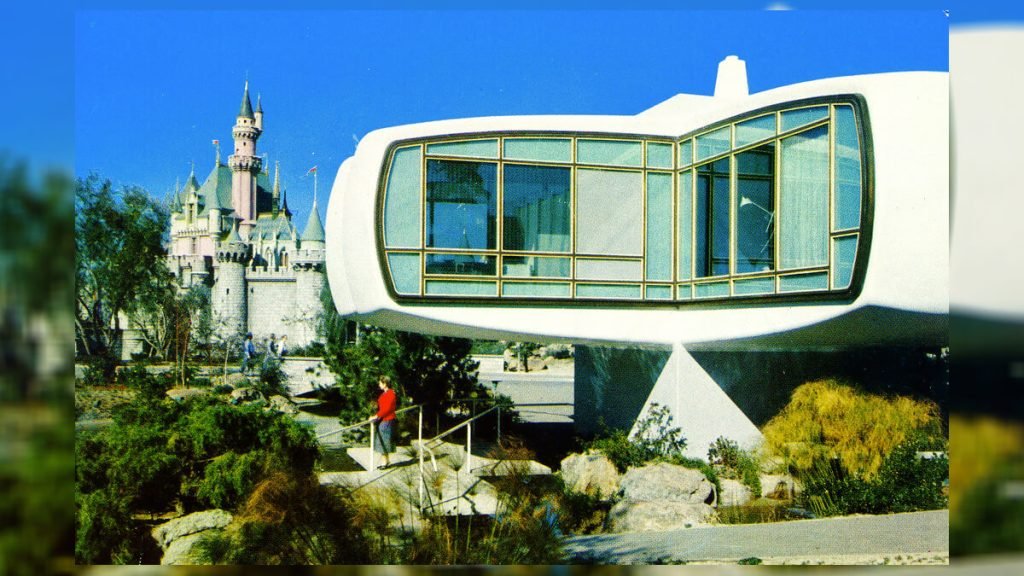
Opening Monsanto’s “House of the Future” at Disneyland
And Walt … Of the heels of construction of Monsanto’s “House of the Future” beginning, he decided to double down on expanding & upgrading Disneyland’s Tomorrowland section. Which is why — just two days before Monsanto’s prototype of a prefabricated plastic home opened to the public on June 12, 1957, Walt cut the ribbon on the Viewliner. Which was advertised as the “Train of Tomorrow.” Though –truth be told – WED’s resident mechanical genius Bob Gurr had cobbled together this futuristic-looking narrow gauge train out of parts he’d harvested off of various Oldsmobiles & Jeeps.
Anyway … Monsanto’s instincts when it came to building its “House of the Future” at Disneyland Park translating into lots of foot traffic for its prefabricated plastic home prototype turned out to be dead on. Within the first six weeks that this new Tomorrowland attraction was open to the public, over 435,000 people toured the “House of the Future.” That’s over 10,000 Guests per day.
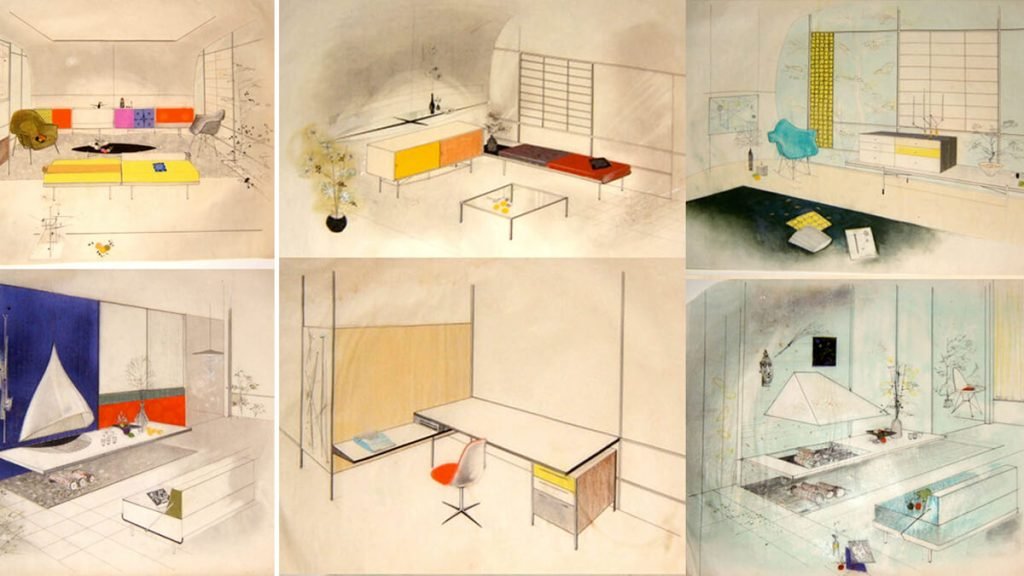
And the Disneyland hosts & hostesses (That’s what Disneyland employees were called back in the late 1950s / early 1960s. Not Cast Members. But – rather – hosts & hostesses) who led tour groups through the prototype of Monsanto’s prefabricated home proudly talked about the 14 different types of plastic that had been used in its construction. They also pointed out the cutting edge tech that had been incorporated into this house’s design. Things like a microwave oven.
The Future of Plastic Homes
But while over 20 million people who trooped through Monsanto’s “House of the Future” during its decade-long stay in Tomorrowland (and then “Ooohed” & “Aaahed” at things like this home’s ultra sonic dishwasher. Which didn’t use any water to clean the all-plastic dishes & utensils that were used in its kitchen) … Unfortunately, Monsanto got very few takers for its prefabricated plastic homes.
Which is why – by the early 1960s – the Company had all but abandoned its original idea of making the manufacture of prefabricated plastic homes a new division for the Monsanto Corporation. Which is why – when Walt approached Monsanto around this same time and said “Hey, we’re thinking of redoing Disneyland’s Tomorrowland area. Do you want to stay on as a sponsor of something on this side of the Park?,” Monsanto’s response was “Yeah. But we want something new. Pull down the ‘House of the Future’ and close the’ Hall of Chemistry.’ This time around, we want some sort of Tomorrowland attraction that the Guests can ride on.”
And that’s exactly what the Imagineers did. They gutted Monsanto’s “Hall Of Chemistry” and then placed an Omnimover inside of that Tomorrowland show building. And that became the ride system which then took Disneyland visitors on an “Adventure Thru Inner Space.” Which first opened to the public on August 5, 1967.
What Happened to Disneylands “House of the Future”?
As for the “House of the Future” … Given that that structure was constructed out of 14 different types of plastics, pulling down this Tomorrowland attraction proved to be problematic. What was supposed to be completed in a single day eventually stretched out into a two week-long ordeal. Largely because this prefabricated plastic house stymied all of the usual methods that Disneyland employees used (i.e., wrecking balls, bulldozers, etc) when they were leveling a show building. In time, they had to go at this futuristic structure with hacksaws & chain pullers. Because that was the only way to reduce the “House of the Future” to small enough pieces that it could then be hauled away.
Mind you, the concrete slab that had served as the “House of the Future” ‘s foundation stayed in place. As did the vaguely futuristic-looking landscaping that Morgan “Bill” Evans and the rest of Disneyland’s horticultural team had planted around this Tomorrowland walk-thu.
Jump ahead a few years. And now that landscaping (which had been originally planted back in 1957 to give the “House of the Future” a lush, green frame) had grown up so much that this section of the Hub was then redubbed this theme park’s Alpine Garden. With the idea now being that this chunk of greenery would now serve as the forested foothills of Matterhorn Mountain.
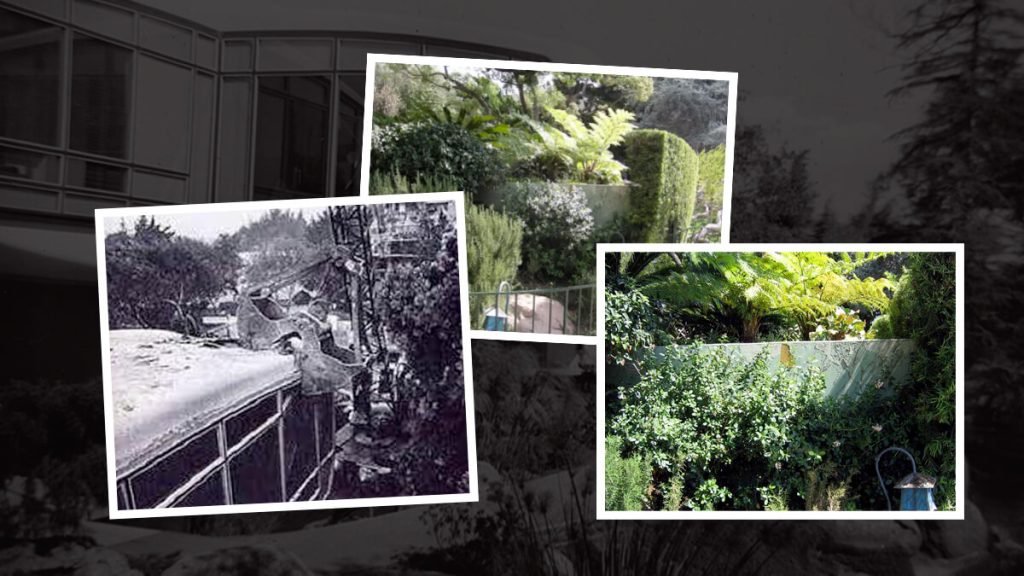
That was done in the early 1970s. Nearly 15 years after that, someone else moved into the neighborhood: The Little Mermaid. Which is why – in 1996 – Disneyland’s Alpine Garden was renamed King Triton’s Garden. Then in 2008, this part of that theme park (which had been changed into a place where Guests could then meet & greet with Ariel) was reimagined as Pixie Hollow. Which then gave Disneyland visitors a place where they could go interact with Tinker Bell.
This meet & greet is still operational at the Happiest Place on Earth. That said, if you look off the right of that oversized teapot which Tink calls home … Well, you can still see that concrete slab which – over 50 years ago now – once served as the foundation for the “House of the Future.”
FYI: If you’d like to learn more about this Tomorrowland walk-thru, Dave Bossert – the author of “Kem Weber: Mid-Century Furniture Designs for the Disney Studios” and “Claude Coats: Walt Disney’s Imagineer—The Making of Disneyland, From Toad Hall to the Haunted Mansion and Beyond” – is in the process of writing a brand-new book, “The House of the Future: Walt Disney, MIT, and Monsanto’s Vision of Tomorrow.” Which is due to be published sometime in 2023.
This article is based on research for The Disney Dish Podcast “Episode 379”, published on June 20, 2022. The Disney Dish Podcast is part of the Jim Hill Media Podcast Network.
Theme Parks & Themed Entertainment
Disney and Macy’s 90-Year Thanksgiving Day Parade Partnership: From Mickey’s First Balloon to Minnie’s Big Debut

Now, folks, if you’re like me, Thanksgiving just wouldn’t be the same without a coffee, a cozy seat, and Macy’s Thanksgiving Day Parade on the TV. And if you’re really like me, you’re watching for one thing: Disney balloons floating down 34th Street. Ever wondered how Mickey, Donald, and soon Minnie Mouse found their way into this beloved New York tradition? Well, grab your popcorn because we’re diving into nearly 90 years of Disney’s partnership with Macy’s.
The Very First Parade and the Early Days of Balloons
The Macy’s Thanksgiving Day Parade goes way back to 1924, but if you can believe it, balloons weren’t part of the festivities until 1927. That first lineup included Felix the Cat, a dragon, and a toy soldier, all towering above the crowds. Back then, Macy’s had a pretty wild idea to end the parade: they would let the balloons drift off into the sky, free as birds. But this wasn’t just Macy’s feeling generous. Each balloon had a message attached, offering a $100 reward (about $1,800 in today’s dollars) for anyone who returned it to the flagship store on 34th Street.
And here’s where it gets interesting. This tradition carried on for a few years, right up until 1932, when Felix the Cat almost took down a plane flying over New York City! Imagine that—you’re flying into LaGuardia, and suddenly, there’s a 60-foot balloon drifting toward your wing. Needless to say, that was the end of Macy’s “fly away” stunt, and from then on, the balloons have stayed firmly grounded after the parade ends.

1934: Mickey Mouse Floats In, and Disney Joins the Parade
It was 1934 when Mickey Mouse finally made his grand debut in the Macy’s parade. Rumor has it Walt Disney himself collaborated with Macy’s on the design, and by today’s standards, that first Mickey balloon was a bit of a rough cut. This early Mickey had a hotdog-shaped body, and those oversized ears gave him a slightly lopsided look. But no one seemed to mind. Mickey was there, larger than life, floating down the streets of New York, and the crowd loved him.
Mickey wasn’t alone that year. He was joined by Pluto, Horace Horsecollar, and even the Big Bad Wolf and Practical Pig from The Three Little Pigs, making it a full Disney lineup for the first time. Back then, Disney wasn’t yet the entertainment powerhouse we know today, so for Walt, getting these characters in the parade meant making a deal. Macy’s required its star logo to be featured on each Disney balloon—a small concession that set the stage for Disney’s long-standing presence in the parade.
Duck Joins and Towers Over Mickey
A year later, in 1935, Macy’s introduced Donald Duck to the lineup, and here’s where things got interesting. Mickey may have been the first Disney character to float through the parade, but Donald made a huge splash—literally. His balloon was an enormous 60 feet tall and 65 feet long, towering over Mickey’s 40-foot frame. Donald quickly became a fan favorite, appearing in the lineup for several years before being retired.
Fast-forward a few decades, and Donald was back for a special appearance in 1984 to celebrate his 50th birthday. Macy’s dug the balloon out of storage, re-inflated it, and sent Donald down 34th Street once again, bringing a bit of nostalgia to the holiday crowd.
A Somber Parade in 2001
Now, one of my most memorable trips to the parade was in 2001, just weeks after the 9/11 attacks. Nancy and I, along with our friends, headed down to New York, and the mood was something I’ll never forget. We watched the start of the parade from Central Park West, but before that, we went to the Museum of Natural History the night before to see the balloons being inflated. They were covered in massive cargo nets, with sandbags holding them down. It’s surreal to see these enormous balloons anchored down before they’re set free.
That year, security was intense, with police lining the streets, and then-Mayor Rudy Giuliani rode on the Big Apple float to roaring applause. People cheered his name, waving and shouting as he passed. It felt like the entire city had turned out to show their resilience. Even amidst all the heightened security and tension, seeing those balloons—brought a bit of joy back to the city.

Balloon Prep: From New Jersey’s MetLife Stadium to California’s D23 Expo
Each year before the parade, Macy’s holds a rehearsal event known as Balloon Fest at MetLife Stadium in New Jersey. This is where handlers get their first crack at guiding the balloons, practicing with their parade masters, and learning the ropes—literally. It’s an entire production unto itself, with dozens of people rehearsing to make sure these enormous inflatables glide smoothly down the streets of New York on parade day.
In 2015, Macy’s took the balloon show on the road, bringing their Buzz Lightyear balloon out to California for the D23 Expo. I was lucky enough to be there, and watching Buzz get inflated piece by piece in the Anaheim Convention Center parking lot was something to behold. Each section was filled with helium in stages, and when they got around to Buzz’s lower half, well, there were more than a few gas-related jokes from the crowd.
These balloons seem to have a personality all their own, and seeing one like Buzz come to life up close—even outside of New York—had all the excitement and anticipation of the real deal.

Mickey’s Comeback as a Bandleader and Sailor Mickey
After a long hiatus, Mickey Mouse made his return to the Macy’s parade in 2000, this time sporting a new bandleader outfit. Nine years later, in 2009, Sailor Mickey joined the lineup, promoting Disney Cruise Line with a nautical twist. Over the past two decades, Disney has continued to enchant parade-goers with characters like Buzz Lightyear in 2008 and Olaf from Frozen in 2017. These balloons keep Disney’s iconic characters front and center, drawing in both longtime fans and new viewers.
But ever wonder what happens to the balloons after they reach the end of 34th Street? They don’t just disappear. Each balloon is carefully deflated, rolled up like a massive piece of laundry, and packed into storage bins. From there, they’re carted back through the Lincoln Tunnel to Macy’s Parade Studio in New Jersey, where they await their next flight.

Macy’s Disney Celebration at Hollywood Studios
In 1992, Macy’s took the spirit of the parade down to Disney-MGM Studios in Orlando. After that year’s parade, several balloons—including Santa Goofy, Kermit the Frog, and Betty Boop—were transported to Hollywood Studios, re-inflated, and anchored along New York Street as part of a holiday display. Visitors could walk through this “Macy’s New York Christmas” setup and see the balloons up close, right in the middle of the park. While this display only ran for one season, it paved the way for the Osborne Family Spectacle of Dancing Lights, which became a holiday staple at the park for years to come.

Minnie Mouse’s Long-Awaited Debut in 2024
This year, Minnie Mouse will finally join the parade, making her long-overdue debut. Macy’s is rolling out the red carpet for Minnie’s arrival with special pop-up shops across the country, where fans can find exclusive Minnie ears, blown-glass ornaments, T-shirts, and more to celebrate her first appearance in the Thanksgiving Day Parade.

For those lucky enough to catch the parade this year, you’ll see Minnie take her first float down 34th Street, decked out in her iconic red bow and polka-dot dress. Macy’s and Disney are also unveiling a new Disney Cruise Line float honoring all eight ships, including the latest, the Disney Treasure.
As always, I’ll be watching from my favorite chair, coffee in hand, as Minnie makes her grand entrance. The 98th annual Macy’s Thanksgiving Day Parade airs live on NBC, and it’s a tradition you won’t want to miss—whether you’re on 34th Street or tuning in from home.
Theme Parks & Themed Entertainment
Disney’s Forgotten Halloween Event: The Original Little Monsters on Main Street

When most Disney fans think of Halloween in the parks, they immediately picture Mickey’s Not-So-Scary Halloween Party at Walt Disney World or the Oogie Boogie Bash at Disneyland Resort. But before those events took over as the must-attend spooky celebrations, there was a little-known event at Disneyland called Little Monsters on Main Street. And its origins? Well, they go all the way back to the 1980s, during a time when America was gripped by fear—the Satanic Panic.

You see, back in the mid-1980s, parents were terrified that Halloween had become dangerous. Urban legends about drug-laced candy or razor blades hidden in apples were widespread, and many parents felt they couldn’t let their kids out of sight for even a moment. Halloween, which was once a carefree evening of trick-or-treating in the neighborhood, had suddenly become a night filled with anxiety.
This is where Disneyland’s Little Monsters on Main Street came in.

The Origins of Little Monsters on Main Street
Back in 1989, the Disneyland Community Action Team—later known as the VoluntEARS—decided to create a safe, nostalgic Halloween experience for Cast Members and their families. Many schools in the Anaheim area were struggling to provide basic school supplies to students, and the VoluntEARS saw an opportunity to combine a safe Halloween with a charitable cause. Thus, Little Monsters on Main Street was born.
This event was not open to the general public. Only Disneyland Cast Members could purchase tickets, which were initially priced at just $5 each. Cast Members could bring their kids—but only as many as were listed as dependents with HR. And even then, the park put a cap on attendance: the first event was limited to just 1,000 children.

A Unique Halloween Experience
Little Monsters on Main Street wasn’t just another Halloween party. It was designed to give kids a safe, fun environment to enjoy trick-or-treating, much like the good old days. On Halloween night in 1989, kids in costume wandered through Disneyland with their pillowcases, visiting 20 different trick-or-treat stations. They also had the chance to ride a few of their favorite Fantasyland attractions, all after the park had closed to the general public.
The event was run entirely by the VoluntEARS—about 200 of them—who built and set up all the trick-or-treat stations themselves. They arrived at Disneyland before the park closed and, as soon as the last guest exited, they began setting up stations across Main Street, Adventureland, Frontierland, Fantasyland, and Tomorrowland. The event ran from 7:30 to 9:30 p.m., and by the time the last pillowcase-wielding kid left, the VoluntEARS cleaned everything up, making sure the park was ready for the next day’s operations.
It wasn’t just candy and rides, though. The event featured unique entertainment, like a Masquerade Parade down Main Street, U.S.A., where kids could show off their costumes. And get this—Disneyland even rigged up a Cast Member dressed as a witch to fly from the top of the Matterhorn to Frontierland on the same wire that Tinker Bell uses during the fireworks. Talk about a magical Halloween experience!
The Haunted Mansion “Tip-Toe” Tour
Perhaps one of the most memorable parts of Little Monsters on Main Street was the special “tip-toe tour” of the Haunted Mansion. Now, Disneyland’s Haunted Mansion can be a pretty scary attraction for younger kids, so during this event, Disney left the doors to the Stretching Room and Portrait Gallery wide open. This allowed kids to walk through and peek at the Haunted Mansion’s spooky interiors without actually having to board the Doom Buggies. For those brave enough to ride, they could, of course, take the full trip through the Haunted Mansion—or they could take the “chicken exit” and leave, no harm done.

Growing Success and a Bigger Event
Thanks to the event’s early success, Little Monsters on Main Street grew in size. By 1991, the attendance cap had been raised to 2,000 kids, and Disneyland added more activities like magic shows and hayrides. They also extended the event’s hours, allowing kids to enjoy the festivities until 10:30 p.m.
In 2002, the event moved over to Disney California Adventure, where it could accommodate even more kids—up to 5,000 in its later years. The name was also shortened to just Little Monsters, since it was no longer held on Main Street. This safe, family-friendly Halloween event continued for several more years, with the last mention of Little Monsters appearing in the Disneyland employee newsletter in 2008. Though some Cast Members recall the event continuing until 2012, it eventually made way for Disney’s more public-facing Halloween events.

From Little Monsters to Mickey’s Not-So-Scary and Oogie Boogie Bash
Starting in the early 2000s, Disney began realizing the potential of Halloween-themed after-hours events for the general public. These early versions of Mickey’s Halloween Party and Mickey’s Halloween Treat eventually evolved into today’s Mickey’s Not-So-Scary Halloween Party and Oogie Boogie Bash. Unfortunately, this also marked the end of the intimate, Cast Member-exclusive Little Monsters event, but it paved the way for the large-scale Halloween celebrations we know and love today.
While it’s bittersweet to see Little Monsters on Main Street fade into Disney history, its legacy lives on through these modern Halloween parties. And even though Cast Members now receive discounted tickets to Mickey’s Not-So-Scary and Oogie Boogie Bash, the special charm of an event created specifically for Disney’s employees and their families remains something worth remembering.
The Merch: A Piece of Little Monsters History
For Disney collectors, the exclusive merchandise created for Little Monsters on Main Street is still out there. You can find pins, name tags, and themed pillowcases on sites like eBay. One of the coolest collectibles is a 1997 cloisonné pin set featuring Huey, Dewey, and Louie dressed as characters from Hercules. Other sets paid tribute to the Main Street Electrical Parade and Pocahontas, while the pillowcases were uniquely designed for each year of the event.

While Little Monsters on Main Street may be gone, it’s a fascinating piece of Disneyland history that played a huge role in shaping the Halloween celebrations we enjoy at Disney parks today.
Want to hear more behind-the-scenes stories like this? Be sure to check out I Want That Too, where Lauren and I dive deep into the history behind Disney’s most beloved attractions, events, and of course, merchandise!
Theme Parks & Themed Entertainment
The Story of Mickey’s Not-So-Scary Halloween Party: From One Night to a Halloween Family Tradition

The spooky season is already in full swing at Disney parks on both coasts. On August 9th, the first of 38 Mickey’s Not-So-Scary Halloween Party (MNSSHP) nights for 2024 kicked off at Florida’s Magic Kingdom. Meanwhile, over at Disney California Adventure, the Oogie Boogie Bash began on August 23rd and is completely sold out across its 27 dates this year.
Looking back, it’s incredible to think about how these Halloween-themed events have grown. But for Disney, the idea of charging guests for Halloween fun wasn’t always a given. In fact, when the very first Mickey’s Not-So-Scary Halloween Party debuted on October 31, 1995, it was a modest one-night-only affair. Compare that to the near month-long festivities we see today, and it’s clear that Disney’s approach to Halloween has evolved considerably.
A Not-So-Scary Beginning
I was fortunate enough to attend that very first MNSSHP back in 1995, along with my then 18-month-old daughter Alice and her mom, Michelle. Tickets were a mere $16.95 (I know, can you imagine?), and we pushed Alice around in her sturdy Emmaljunga stroller—Swedish-built and about the size of a small car. Cast Members, charmed by her cuteness, absolutely loaded us up with candy. By the end of the night, we had about 30 pounds of fun-sized candy bars, making that push up to the monorail a bit more challenging.

This Halloween event was Disney’s response to the growing popularity of Universal Studios Florida’s own Halloween hard ticket event, which started in 1991 as “Fright Nights” before being rebranded as “Halloween Horror Nights” the following year. Universal’s gamble on a horror-themed experience helped salvage what had been a shaky opening for their park, and by 1993, Halloween Horror Nights was a seven-night event, with ticket prices climbing as high as $35. Universal had stumbled upon a goldmine, and Disney took notice.
A Different Approach
Now, here’s where Disney’s unique strategy comes into play. While Universal embraced the gory, scare-filled world of horror, Disney knew that wasn’t their brand. Instead of competing directly with blood and jump-scares, Disney leaned into what they did best: creating magical, family-friendly experiences.
Thus, Mickey’s Not-So-Scary Halloween Party was born. The focus was on fun and whimsy, not fear. Families could bring their small children without worrying about them being terrified by a chainsaw-wielding maniac around the next corner. This event wasn’t just a Halloween party—it was an extension of the Disney magic that guests had come to expect from the parks.
Disney had some experience with seasonal after-hours events, most notably Mickey’s Very Merry Christmas Party, which had started in 1983. But the Halloween party was different, as the Magic Kingdom wasn’t yet decked out in Halloween decor the way it is today. Disney had to create a spooky (but not too spooky) atmosphere using temporary props, fog machines, and, of course, lots of candy.
A key addition to that first event? The debut of the Headless Horseman, who made his eerie appearance in Liberty Square, riding a massive black Percheron. It wasn’t as elaborate as the Boo-to-You Parade we see today, but it marked the beginning of a beloved Disney Halloween tradition.
A Modest Start but a Big Future
That first MNSSHP in 1995 was seen as a trial run. As Disney World spokesman Greg Albrecht told the Orlando Sentinel, “If it’s successful, we’ll do it again.” And while attendance was sparse that night, there was clearly potential. By 1997, the event expanded to two nights, and by 1999, Mickey’s Not-So-Scary Halloween Party had grown into a multi-night celebration with a full-fledged parade. Today, in 2024, it’s a staple of the fall season at Walt Disney World, offering 38 nights of trick-or-treating, character meet-and-greets, and special entertainment.
Universal’s Influence

It’s interesting to reflect on how Disney’s Halloween event might never have existed without the competition from Universal. Just as “The Wizarding World of Harry Potter” forced Disney to step up their game with “Star Wars: Galaxy’s Edge,” Universal’s success with Halloween Horror Nights likely spurred Disney into action with MNSSHP. The friendly rivalry between the two parks has continually pushed both to offer more to their guests, and we’re all better off because of it.
So the next time you find yourself trick-or-treating through the Magic Kingdom, watching the Headless Horseman gallop by, or marveling at the seasonal fireworks, take a moment to appreciate how this delightful tradition came to be—all thanks to a little competition and Disney’s commitment to creating not-so-scary magic.
For more Disney history and behind-the-scenes stories, check out the latest episodes of the I Want That Too podcast on the Jim Hill Media network.
-

 History10 months ago
History10 months agoThe Evolution and History of Mickey’s ToonTown
-

 History11 months ago
History11 months agoUnpacking the History of the Pixar Place Hotel
-

 History11 months ago
History11 months agoFrom Birthday Wishes to Toontown Dreams: How Toontown Came to Be
-

 Film & Movies8 months ago
Film & Movies8 months agoHow Disney’s “Bambi” led to the creation of Smokey Bear
-

 News & Press Releases10 months ago
News & Press Releases10 months agoNew Updates and Exclusive Content from Jim Hill Media: Disney, Universal, and More
-

 Merchandise8 months ago
Merchandise8 months agoIntroducing “I Want That Too” – The Ultimate Disney Merchandise Podcast
-

 Theme Parks & Themed Entertainment3 months ago
Theme Parks & Themed Entertainment3 months agoDisney’s Forgotten Halloween Event: The Original Little Monsters on Main Street
-

 Film & Movies3 months ago
Film & Movies3 months agoHow “An American Tail” Led to Disney’s “Hocus Pocus”





